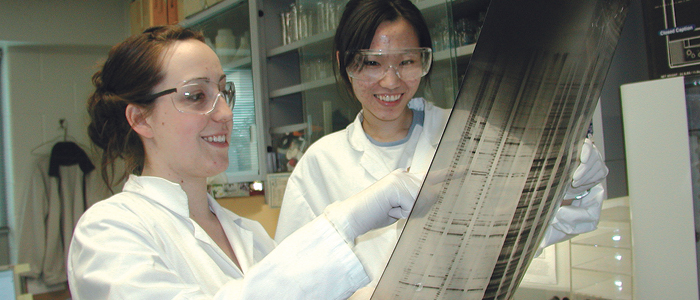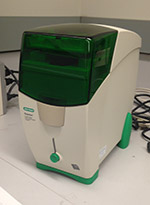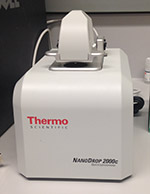Molecular Genetics Unit (MGU)

Two students examining a DNA print out in MGU
MGU core provides a number of facilities in the field of plant and animal molecular biology, molecular genetics and general life science research. The following faculty members use the facility on daily basis: Dr. Susanne Kohalmi (Arogenate dehydratase family [ADTs] gene family and regulation in Arabidopsis thaliana), Dr. Kathleen Hill (Mutation analysis, genome organization and Integrity), Dr. Greg Kelly (Cell signaling in vertebrate embryo), Dr. T Percival-Smith (Molecular mechanisms of morphogenesis in Drosophila melanogaster ), Dr. V Grbic (Arabidopsis development genetics) and Dr. Sashko Damjanovski (Extracellular matrix remodeling in developing Xenopus laevis). The MGU Core facility is available for similar research by other Biology Faculty for a user fee. It is located on the third floor of the Western Science Centre.
It is a large and well-equipped common area (242m2) which includes State-of-art gel documentation facility (Chemi-touch Doc digital imaging of DNA/RNA and Western blotting), Real time PCR (CFX 96), Nanodrop 2000C (DNA/RNA quantification, density of cell cultures, protein measurements), Animal and Plant Culture rooms, Microscopy and Imaging (Leica DMR BE fluorescence), Ultrapure water system, Steam Autoclaves for sterilization of biological samples, Hot air sterilization ovens, high speed ultra-centrifuges, cold room, incubators, vacuum pump and concentrators, homogenizers, and laminar flow hoods.
Instruments
User Fee
|
Instrument training Fee |
Cost-Western Account holders |
Cost-PO Payment |
|
QX-200 ddPCR |
$340 |
$424 |
|
Real-time PCR |
$252 |
$300 |
|
All other training |
$60/hr |
$60/hr |
|
Other Instruments-- |
|
|
|
Nanodrop |
$100/month… maximum $1000/year |
|
|
Ovens/Autoclaves/centrifuges |
$250/year | |
|
|
||
|
Instrument Usage Fee |
Cost-Western Account holders |
Cost-PO Payment |
|
QX200 Droplet generator (incl. cartridge) |
$20/8 sample cartridge |
$24/8sample cartridge |
|
QX200 Droplet reader |
$2 samples |
$9/8 samples |
|
|
|
|
|
real-time PCR |
$40/run |
|
|
Experion |
$60/chip (samples 1-12) |
Services
Consultations + Demonstration
Custom training – DNA/RNA isolation, amplification and characterization, PCR and QPCR, Western blotting, Immunostaining, Primer designing, cloning.
Policy
Access
MGU is located in Western Science Center WSC, room 357 and it is open on weekdays from 9:00 am until 5:00 pm. During these hours, the Facility manager will be available for training and consultation regarding the instruments. The staff or student card can be registered in order to gain card access to the facility after hours. During after hours, the user will be held responsible for ensuring that doors are kept locked at all times.
Responsibilities of Users and their Supervisors
Users must be trained by the Facility staff to ensure safe usage of the equipment. Log books are provided for each instrument and users are expected to log in their time of usage. When the work is complete, the user should ensure that the work area is left clean. Any problems or concerns can be noted in the log books or the user can contact the Facility manager. In the event of instrument damage due to abuse, misuse, or unauthorized use, the research supervisor will be held financially responsible for the cost of repair or replacement.
Billing
The facility will charge fees in order to cover the cost of consumables and instrument operating costs as defined in the fee section. Users must provide a valid speed-code or account number for invoicing.
Publications
Nieuwesteeg, M. Walsh, L.A., Fox, M.A. and Damjanovski, S. 2012. Domain specific overexpression of TIMP-2 and TIMP-3 reveals MMP-independent functions of TIMPs during X laevis development. Biochem Cell Biol. r2011-0088.
Walsh, L.A., Cepeda, M.A. and Damjanovski, S. 2012. Analysis of MMP-dependent and independent functions of tissue inhibitor of metalloproteinase-2 on the invasiveness of breast cancer cells. J. Cell Comm.Signal. 2012 Jan 8.
Rosloski SM, Jali SS, Balasubramanian S, Weigel D, Grbic V. (2010) Genomic rearrangements and natural variation in splicing of MADS AFFECTING FLOWERING 2 leads to diverse flowering responses in Arabidopsis thaliana. Genetics 186, 263-276.
Wang Q, Sajja U, Rosloski S, Humphrey T, Kim MC, Bomblies K, Weigel D, Grbic V. (2007) HUA2 Caused Natural Variation in Shoot Morphology of A. thaliana. Curr Biol. 17, 1513-1519.
Poduska B, Humphrey T, Redweik A and Grbic V (2003) The synergistic activation of FLOWERING LOCUS C by FRIGIDA and a new flowering gene AERIAL ROSETTE 1 underlies a novel morphology in Arabidopsis. Genetics 163, 1457-1465.
Smith CA, Newson TA, Leonard KC, Barfett J, Holdsworth DW, Hutnik CM, Hill KA. A framework for modeling ocular drug transport and flow through the eye using micro-CT. Phys Med Biol. 2012 Oct 7;57(19):6295-307.
Ward TL, Prtenjaca A, Hill KA, A novel E. coli-derived mutation detected with the Big Blue ÒcII mutant selectable assay. Environ Mol Mutagen 2010 Jan 29.
Van Osch FS, Piliguian M, Hill KA, Spontaneous mutation frequency is elevated in skin of harlequin (hq)/Big Blue Ò mice. Mutagenesis 2010 Jan 20.
Butler JL, Osborne Locke ME, Hill KA, Daley M. HD-CNV: hotspot detector for copy number variants. Bioinformatics. 2013 Jan 15;29(2):262-3.
Wen, J.W.H., Hwang, J.T.K., and G.M. Kelly. Reactive oxygen species and Wnt signalling crosstalk patterns mouse extraembryonic endoderm. 2012 Cell. Signal. 24(12):2337-2348.
Hwang, J.T.K. and G.M. Kelly. GATA6 and FOXA2 regulate Wnt6 expression during extraembryonic endoderm formation. 2012 Stem Cells Dev. 21(17):3220-3232.
Sun, Q. and G.M. Kelly. Post-translational modification of CASK leads to its proteasome-dependent degradation. 2010 Int. J. Biochem. Cell Biol. 42(1):90-97.
Tian, G ., Lu, Q., Zhang, L., Kohalmi, S.E., Cui, Y. 2011. Detection of protein interactions in plant using a gateway compatible bimolecular fluorescence complementation (BiFC) system. Journal of Visualized Experiments doi: 10.3791/3473.
Bross, C.D., Corea, O.R.A., Kaldis, A., Menassa, R., Bernards, M.A., Kohalmi, S.E. 2011. Complementation of the pha2 yeast mutant suggests functional differences for arogenate dehydratases from Arabidopsis thaliana. Plant Physiology and Biochemistry, 49, 882-890.
T. Fatima, C. Snyder, WR. Schroeder, D. Wishart, RJ Weselake and P Krishna. 2012. Transcriptome and metabolite analysis of polyunsaturated fatty acid-enriched sea buckthorn (Hippophae rhamnoides L.) seed. PLoS ONE. 7(4):e34099 (1-18 pages)
Isidro J, Knox R, Singh AK, Clarke F, Krishna P, DePauw R, Clarke J, Somers D. 2012. Brassinosteroid leaf unrolling QTL mapping in durum wheat. Planta Feb 18.
Udaka H, Percival-Smith A, Sinclair BJ. Increased abundance of Frost mRNA during recovery from cold stress is not essential for cold tolerance in adult Drosophila melanogaster. Insect Mol Biol. 2013 Jul 31. doi: 10.1111/imb.12044.
Moazzen H, Rosenfeld R, Percival-Smith A. Non-requirement of a regulatory subunit of Protein Phosphatase 2A, PP2A-B', for activation of Sex comb reduced activity in Drosophila melanogaster. Mech Dev. 2009 Aug-Sep;126(8-9):605-10.
Kleiber ML, Mantha K, Stringer RL, Singh SM. Neurodevelopmental alcohol exposure elicits long-term changes to gene expression that alter distinct molecular pathways dependent on timing of exposure. J Neurodev Disord. 2013 Mar 13;5(1):6.
Laufer BI, Mantha K, Kleiber ML, Diehl EJ, Addison SM, Singh SM. Long-lasting alterations to DNA methylation and ncRNAs could underlie the effects of fetal alcohol exposure in mice. Dis Model Mech. 2013 Jul-Aug;6(4):977-92.
Wu T, Dhami GK, Thompson GJ. Soldier-biased gene expression in a subterranean termite implies functional specialization of the defensive caste. Evol Dev. 2018 Jan;20(1):3-16.
Uddin R, Singh SM. Gene Network Construction from Microarray Data Identifies a Key Network Module and Several Candidate Hub Genes in Age-Associated Spatial Learning Impairment. Front Syst Neurosci. 2017 Oct 10;11:75.
Prtenjaca A, Tarnowski HE, Marr AM, Heney MA, Creamer L, Sathiamoorthy S, Hill KA. Relatively high rates of G:C → A:T transitions at CpG sites were observed in certain epithelial tissues including pancreas and submaxillary gland of adult big blue® mice. Environ Mol Mutagen. 2014 Jan;55(1):51-63.
Willson JA, Muir CA, Evered CL, Cepeda MA, Damjanovski S. Stable expression of α1-antitrypsin Portland in MDA-MB-231 cells increased MT1-MMP and MMP-9 levels, but reduced tumour progression. J Cell Commun Signal. 2017 Aug 29.
Cepeda MA, Evered CL, Pelling JJH, Damjanovski S. Inhibition of MT1-MMP proteolytic function and ERK1/2 signalling influences cell migration and invasion through changes in MMP-2 and MMP-9 levels. J Cell Commun Signal. 2017 Jun;11(2):167-179.
Suzuki T, España MU, Nunes MA, Zhurov V, Dermauw W, Osakabe M, Van Leeuwen T, Grbic M, Grbic V. Correction: Protocols for the delivery of small molecules to the two-spotted spider mite, Tetranychus urticae. PLoS One. 2017 Dec 15;12(12).
Deol GSJ, Cuthbert TN, Gatie MI, Spice DM, Hilton LR, Kelly GM. Wnt and Hedgehog Signaling Regulate the Differentiation of F9 Cells into Extraembryonic Endoderm. Front Cell Dev Biol. 2017 Oct 25;5:93.
Kelly GM, Gatie MI. Mechanisms Regulating Stemness and Differentiation in Embryonal Carcinoma Cells. Stem Cells Int. 2017;2017:3684178.
Contact
The MGU core facility is managed by Dr. Gurpreet Dhami (gdhami2@uwo.ca), WSC 343, x 86406.




